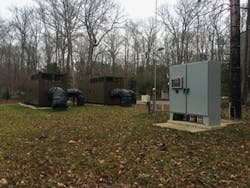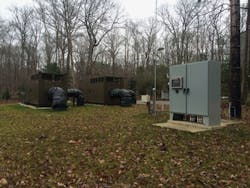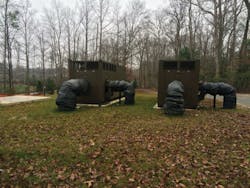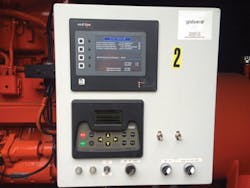SSO Solution Reduces Force Main Pressure
By Hunter Powell
Hampton Roads Sanitation District (HRSD), the regional wastewater treatment utility that serves 18 cities and counties in southeast Virginia, had been experiencing high pressures in its Williamsburg-area force main network during wet weather events. These high-pressure events caused operational trouble and, on occasion, resulted in sanitary sewer overflows (SSOs) in the collection system. Since the Regional Wet Weather Management Plan (RWWMP) of HRSD’s Federal Consent Decree to address these SSO issues was still years from finalization, HRSD staff studied the problem to come up with options to mitigate the issue. One possible option was to completely revamp and upgrade a number of pump stations with new pumps, piping and the necessary control equipment to address increased flow and pressures. Another option considered was to install a pressure reducing station (PRS) along the sewer force main system to reduce system pressures and thus increase capacity. After many options were evaluated, the preferred and most cost-effective solution that could address the situation was an interim PRS. After HRSD’s procurement staff found the necessary purchasing mechanism to move forward with the solution, the local Xylem branch offered its support and assistance with the design, action plan, purchase, and equipment coordination.
A Short- and Long-Term View
HRSD developed a plan to integrate a PRS at a strategic location along the force main. Given HRSD’s dedication to regulatory compliance and environmental stewardship, and the need to align with long-term planned upgrades in its network, the new pressure-reducing station was designed and implemented with the Godwin Dri-Prime Backup System (DBS). The Godwin DBS offered pumping equipment to provide additional capacity to handle wet weather flows and pressures and to minimize issues with SSOs during these events.
The short-term need was to get the PRS on Route 199 near Colonial Williamsburg on-line as soon as possible. The HRSD design engineer provided design specifications to the Xylem team, and Xylem recommended two Godwin diesel-driven, critically silenced CD500M pumps with Final Tier 4 low-emission engines. The fuel supply was provided by two Godwin 250-gallon diesel fuel cubes with double-wall containment to ensure environmental safety. Given the historic sensitivities of neighboring Colonial Williamsburg, the pumps and fuel cubes were also customized to a specific color (Weathered Bark) to comply with county requirements.
A Customized Solution
Xylem engineers customized the Godwin Advanced PrimeGuard Controller to tie into the HRSD supervisory control and data acquisition (SCADA) system, to activate and control the pumps via local pressure readings. The Xylem team engineered a solution for HRSD that allowed the Godwin DBS pump to automatically maintain a specific designed suction pressure setting by ramping the diesel engine up and down based on measured suction pressure levels. At the end of a wet weather event, the controller would ramp down the RPMs and stop the DBS pumps.
Based on additional requirements of the procurement conditions from HRSD, the Xylem team customized the pump controls so they could be accessed in three different ways:
- Automatic: Pumps turned on/off via pre-set parameters (pressure, flow, or level) with the Advanced PrimeGuard Controller.
- Manual: Pumps operated manually on-site, via the Advanced PrimeGuard Controller.
- Pass Thru: Pumps operated remotely via the HRSD SCADA system, which was tied in to the Godwin Advanced PrimeGuard Controller. This future remote control ability will be invaluable during extreme weather events - whether it’s a hurricane or severe snow/ice conditions - when roads are oftentimes closed by local or state authorities, making access to the PRS site impossible. However infrequent these events might be, HRSD considered the Pass Thru capability to be critical as a way to address these specific scenarios.
Additional customized components of Xylem’s unique solution for the Williamsburg PRS included a junction box to provide access to electrical controls as needed, and an interior work light and exterior working lights at the suction inlets for emergency/night work. In order to ensure remote access to the pump controls even during a long-term power outage event, the system was outfitted with a power inverter to recharge the remote SCADA controller batteries. Given the possibility for cold weather in its Virginia locale, HRSD required the system to be weatherized. Xylem outfitted the pumps with block heaters and a battery trickle-charger, and the suction lines were set up to drain with pump shut-off. HRSD also equipped the suction and discharge pipes with heat cables and wrapped them with insulation.
Xylem completed delivery of the equipment and assisted in the installation and testing of the project, which included technical and manpower support to the HRSD operations team during the installation and testing process. Xylem also hired and managed the crane service to unload and lower the pumps into position onto the HRSD-constructed concrete pads.
Long-Term Care
To extend the life of the pumps and to ensure maximum equipment uptime, HRSD technicians are on-site weekly, servicing the pumps to ensure operational readiness should wet weather conditions occur. As HRSD seeks to enhance capacity throughout its entire network, it will continue to consider implementing pressure-reducing stations as sound short-term solutions.
“The installation of pressure-reducing stations in strategic locations along our force main network enabled us to stay on track with our long-term pump station upgrade plans, while realizing substantial cost savings and immediately addressing hydraulic problems in the short term,” said Bruce W. Husselbee, P.E., director of engineering for HRSD. “The plan we put in place with the Xylem team was very collaborative and successful.”
About the Author: Hunter Powell is the senior applications engineer for the southeast region for Xylem Dewatering. He can be reached at [email protected].



